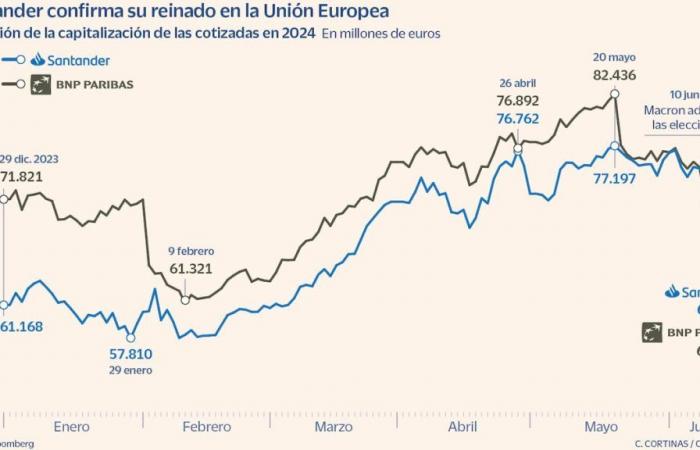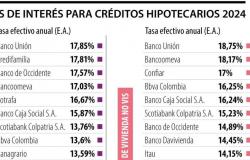
The optimism that ran through the markets has been interrupted by the political earthquake that France is experiencing. Investors, who since November have done nothing but increase their appetite for risk due to the fear of missing out, are taking advantage of the doubts to make cash. Monday’s comeback attempt does not erase last week’s losses. Although the declines are widespread, the French stock market, with banks at the helm, bears the brunt. Coinciding with the loss of the reign of the French Cac as the largest market in Europe, Santander has snatched from BNP Paribas the throne of the most valuable bank in the European Union.
With a fall of 10.89% on the stock market in the last week, the French representative has evaporated 8,175.76 million euros and leaves its capitalization at 66,876.4 million euros. Although Santander has not remained outside the correction of recent days, the entity chaired by Ana Botín limits the fall to 6.8%. This is enough for Santander to consolidate itself once and for all as the most valuable bank in the region with a stock market value of 69,790.8 million.
On May 21, the Spanish bank made a first approach and at times snatched the scepter from the Frenchman, a situation that had not been seen for four years. Just a month ago, the European banking sector continued to make the most of the good results from the start of the first quarter and the rumors of banking consolidation. Beyond BBVA’s takeover bid for Sabadell, investors celebrated the support of French President Emmanuel Macron for mergers between the main European banks to strengthen the financial integration of the EU. The possibility that the worst forecasts will come true and that Macron’s party will not advance to the second round of the French elections puts cross-border integration in suspense. As Janus Henderson analysts point out, this is especially negative for banks. Expectations of pan-European M&A activity in the sector leading to a more consolidated market will now be dimmed.
Along with the paralysis of the European project, analysts highlight the impact that the rise in debt yields may have on the portfolio. One of the lessons that the eurozone debt crisis left behind is that country risk is closely linked to financial risk. As a strategy to increase their income, entities purchase debt. In addition to pocketing the coupons, banks hope to obtain extra from rising prices, a trend that reverses in episodes of stress. As yields rise, the price, which evolves in reverse, falls. This could be seen in the fall of Silicon Valley Bank, which revealed losses of 1.8 billion dollars due to the sale of its debt portfolio at a loss.
Although the market has become tense, the situation in French banking is not so weak. BNP earned 3,010 million in the first quarter, 27% above what analysts expected, and higher than the 2,852 million recorded by Santander.
Good reviews
Despite the poor performance of recent days, analysts continue to be optimistic about the future of the French bank. 66.7% of the firms that follow value advise buying shares, compared to 29.6% that recommend keeping in the portfolio and only 3.7% opt for selling. In recent days Alphavalue has made a move and has revised its valuation upwards. The analysis firm advises buying and sets the target price at 73.9 euros, slightly below the 79.8 euros established by the Bloomberg consensus.
Barclays, one of the firms that maintains the BNP Paribas rating as a buy, highlights the outlook for the year as a whole disclosed in the latest results presentation. According to what was stated in its latest report, the bank expects to increase its income by 2%. This is equivalent to at least 47.9 billion euros, higher than the 47.8 billion consensus.
BNP Paribas’ recommendations are very similar to those of Santander. 71.9% of the firms advise buying, compared to 25% that recommend holding and 3.1% that choose to sell. Although the most immediate challenge is to recover the level of 4.5 per share, the Bloomberg consensus is optimistic and sets the target price at 5.56 euros. That is, they give it a potential of 26%.
Pending the next update, Bankinter’s analysis department keeps the Spanish entity in its portfolio. Among the reasons that justify it is the fact that the CET1 capital ratio remains at a comfortable level (12.3%) and in terms of efficiency it is among the best in European banking.
Experts highlight that the interest margin surprised positively, with an increase of 17.6% in the first quarter, thanks to commercial activity and high rates. As a culmination of these good valuations, analysts point to credit quality. At the end of March, the delinquency rate stood at 3.1%, below the 3.4% recorded at the end of 2023.
Although Santander has managed to take the crown from BNP, the capitalization of the Spanish entity continues to be below Iberdrola and Inditex, the two most valuable listed companies on the Spanish stock market. Since the presentation of its results, the textile group is unbeatable. With an increase of 17.7% in the year, Inditex’s capitalization reaches 144,740 million, a far cry from Iberdrola’s 76,920 million.
Follow all the information Five days in Facebook, x and Linkedinor in our newsletter Five Day Agenda
Newsletters
Sign up to receive exclusive economic information and the financial news most relevant to you
Sign up!





